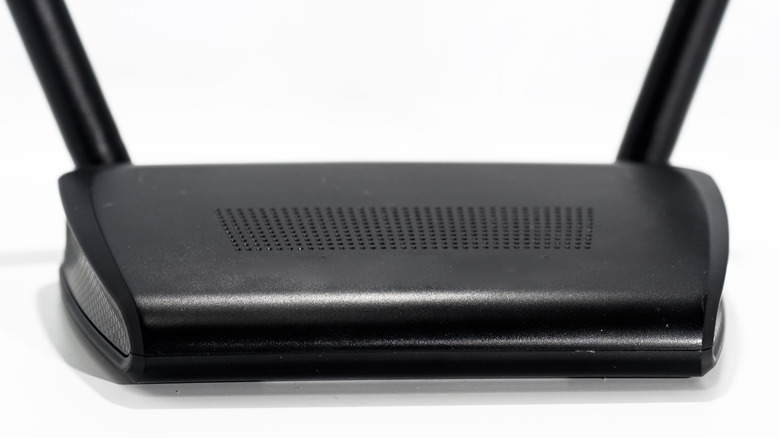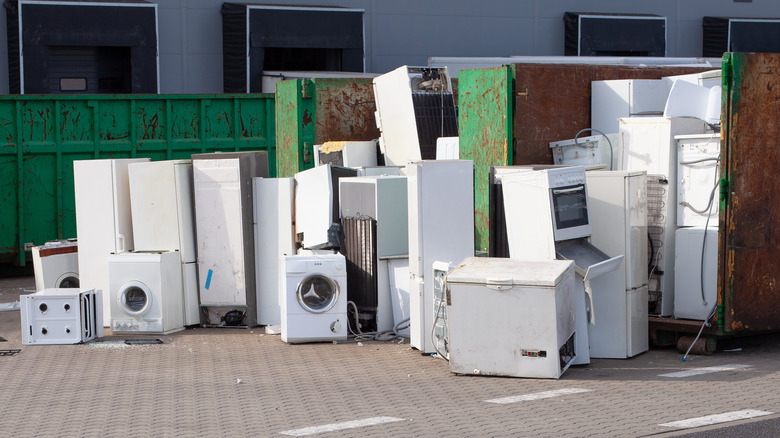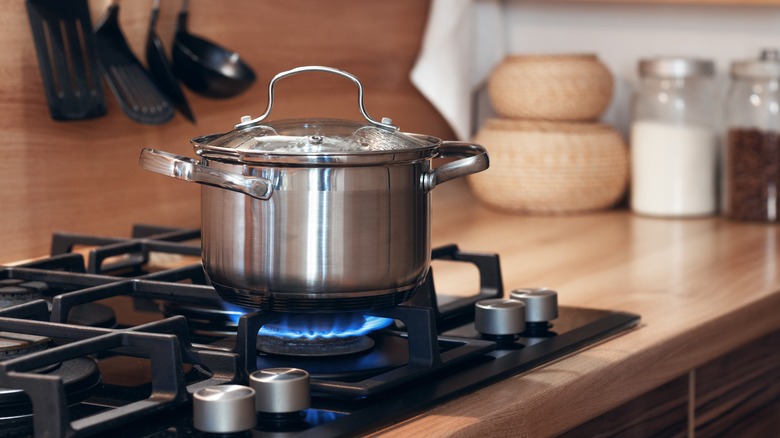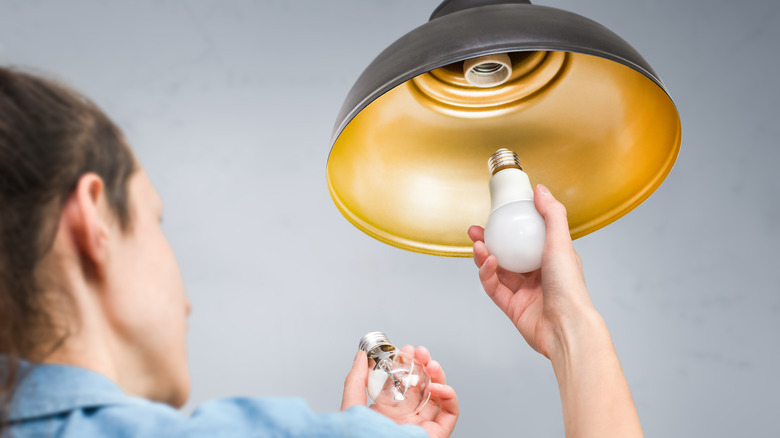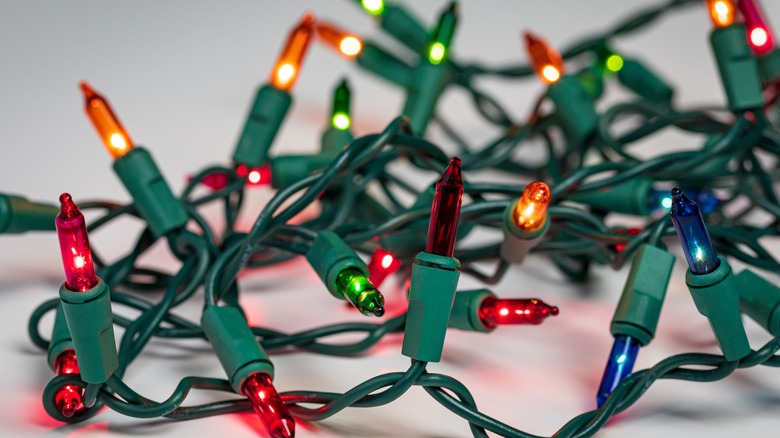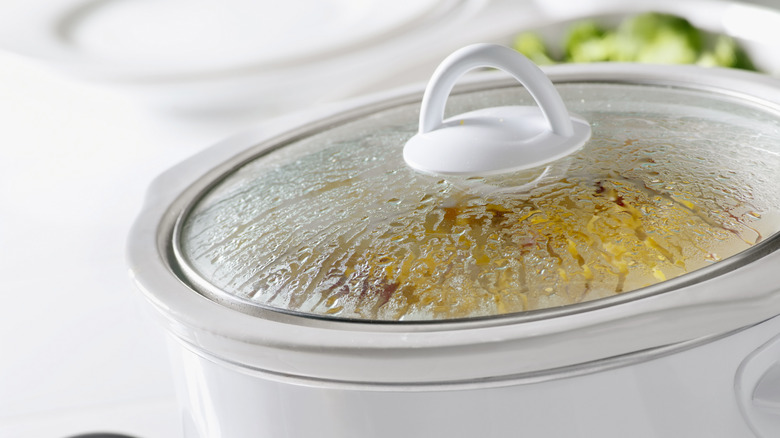10 Nostalgic Items At Your Parents' House That Are More Risky Than They Are Thrifty
When you visit home for the holidays, you may be greeted with a wave of nostalgia. An old toy, a chair you remember sitting on as a kid, or even the CRT TV in the attic might bring on a rush of memories that take you right back to your childhood. But not everything that has survived a few decades in the family home is worth clinging on to. Some of the stuff your folks or other older relatives insist on still using could be downright dangerous.
There are multiple ways older household objects might cause problems. Some of the materials used in their construction may have since turned out to be a health hazard. Sometimes the way an older object is put together might create a fire risk. Some tech-related hazardous objects are also comparatively new, but still no less dangerous — though they are more of a danger to email and bank accounts than they are to anyone's physical well-being.
To help you out, we've compiled a list of objects that may be lingering on in many households, but should really be replaced. Identifying those objects is easy enough, but it's also only half the battle. When it comes to convincing your parents it's time to toss their 40-year-old BPA-laced blender — the facts in this piece may help, but you're ultimately on your own.
Check your relative's router isn't running WPA 2
Though a router may be running "perfectly well" in your parents' eyes, obsolescence carries with it some significant dangers. Relatively recently, the world of Wi-Fi made a significant move: the old security protocol WPA 2 was confined to history and the world welcomed WPA 3.
WPA 3 actually made its debut back in 2018, and from 2020 all new Wi-Fi devices have it built in as standard. Even if WPA 2 was still supported, the level of encryption offered by WPA 3 is vastly greater and the upgrade is certainly worth it. But support for WPA 2 has been withdrawn, and that makes the situation much more pressing. An obsolete Wi-Fi security protocol opens your parent's network, and every device connected to it, up to potential attackers.
While there's a chance they don't trust online banking, there could still be a lot of personal information on whatever phones, tablets, and computers your folks are using. Specialist and high-end routers can cost several hundred dollars, but there are plenty on the market for a very reasonable price. You can upgrade your parent's network security and give them access to a higher-speed connection, such as Wi-Fi 6e, with a very minor investment.
That old tablet isn't getting updates
Tablets are an easy way to perform basic computing tasks very easily. While an older person may struggle with the kinds of operating systems a PC or laptop runs, something like an iPad with its app-based OS can be a simple way to browse the web, check emails, and play casual games.
However, much like the kind of OS a PC runs on, a tablet's software is only supported for a certain period of time. OS version updates will stop first, which means the tablet will miss out on new features, and updated versions of its apps may no longer function properly on the device. Security updates tend to be available for longer, and a device being cut off from future security updates should be what confines it to a drawer for all eternity.
There are exceptions. If the device is only being used offline, or it isn't connected to any sensitive accounts, then the risk is far lower. But if the tablet's user has social media accounts, email accounts, or banking apps installed — then it's time for an upgrade. Hardware issues are less of a problem, as something like a battery can be easily replaced when it's past its prime. Recent advances in right-to-repair legislation may make keeping the hardware side of things functioning even easier in the future.
Your parents' computer OS is no longer supported
As with tablets and phones, companies only support a computer's operating system for so long. If your parent's PC is still running Windows 7, 8, or even Windows XP, then the OS will need updating at the very least, as it is a security risk. Modern operating systems tend to be more demanding than their predecessors, with Windows 11 having a particularly high barrier to entry. In light of that, you may either have to opt for an alternative OS or buy an entirely new device.
If you do manage to coax your parents into upgrading to Windows 10, you should be aware that it's the next OS on Microsoft's hit list. Support for non-enterprise versions is set to be pulled in 2025, which means at the time of writing there are less than two years left on the clock. So while it may be a decent stopgap, you'll have to look to Windows 11 for a longer-term solution.
Their appliances don't have energy ratings
As the old saying goes, "They don't make them like they used to." There may be some truth to that statement, and that could be why you're more likely to encounter appliances from 50 years ago than 20 years ago. But build-quality aside, things have come a long way in the last few decades. While that old washing machine, dishwasher, or fridge is still soldiering on, it could be time to finally retire it.
If the appliance was made before the '90s, then the chances are it won't come with an energy efficiency rating. To put it in simple terms, these ratings tell consumers how much energy the unit uses while doing its job. The higher the efficiency rating, the less power it needs compared to similar machines. Environmental benefits aside, a higher rating likely means you'll save a significant amount on your electricity bill over the machine's lifespan.
The dangers of older machines go beyond how they were constructed. There's a good chance dirt has built up in an older machine, and this can both hamper its performance and increase the amount of danger it poses. If a good amount of dirt, dust, and debris is present on the back of a fridge, or the interior of your dryer is mostly lint, then you have a couple of serious fire hazards on your hands. Checking both the age of your parents' large appliances and the condition they're in could avert a major disaster.
Check the plastic composition of older products
Plastic, and the chemicals within it, are pretty controversial these days for a number of reasons. There are major environmental concerns and worries about the common material's effects on human health. One kind of plastic that has been strongly associated with health problems is BPA.
The health problems scientists have previously linked to BPA include diabetes, cardiovascular disease, high blood pressure, reproductive disorders, and some cancers. As a result, it's best avoided — especially if the product containing it comes into contact with food and involves the use of heat. BPA is rarely seen in modern products, but it used to appear in a wide range of appliances and containers.
Luckily, it's easy enough to check if plastic may contain this dangerous chemical. Closely examine the piece of plastic you're worried may contain BPA and look for a triangle with a number inside of it. If the triangle contains the numbers 3, 6, or 7, then it's likely that the plastic it is stamped on contains BPA. You should discard the plastic item as soon as you can and avoid using it until then. Some products may also clearly state that they are BPA-free — though these tend to be newer and may not actually be as safe as you think.
It may be time to leave gas-powered appliances behind
A few states are targeting the removal of gas-powered appliances and it's not just for environmental reasons. There's also the cost of maintaining a gas network, which officials in New York put at $60,000 per household, to consider. Beyond that, there are the potential effects on health. Natural gas tends to contain high levels of benzene, which is a known carcinogen. Even discounting the effects of inhaling even small amounts of benzine over a long period — a leak in a home's gas system can easily lead to a fire or even an explosion big enough to take out the house and possibly damage several adjoining houses.
It may be hard to give up something like a gas stove. Gas cooking has a lot of benefits, including the ability to "flame grill" things, and providing a way to instantly adjust the amount of heat going through a pan. But given the way things are going, it's probably worth helping your folks look into alternative cooking methods. Even if there isn't an outright ban, there's a good chance gas-powered appliances and heating systems will become drastically more expensive as more people switch to safer and more sustainable alternatives. Making the switch now (or in the near future) may be a good way to get ahead of the price curve and save a significant amount of money in the long run.
Incandescent lightbulbs aren't the way
People don't tend to like change, and despite the numerous benefits of energy-saving lightbulbs, the warm yellow glow of an incandescent bulb is still the preferred choice in many households. Still, the switch is definitely worth considering as, in addition to helping combat climate change, a switch to energy-saving lightbulbs can save a household hundreds of dollars over the bulbs' lifetime. The savings come from a combination of lower electricity bills, and the long life of the bulbs themselves. Energy-saving bulbs last far longer, so even if there's a higher initial cost, the bulb should still be going a decade later.
In terms of practicality, modern LED bulbs come with more options. You can hook many of them up to a smart home system or app and subsequently set the bulb's brightness or color to whatever takes your fancy at the time. The bulbs can also be set to a schedule or controlled remotely, which helps them function as a kind of security tool while you're away from home.
Energy-saving bulbs are also safer in at least one department. Part of the reason they are more efficient is the lack of heat they generate. The heat of an incandescent bulb is essentially a waste product and a potential problem. If you grab an incandescent bulb that's been on for a while, you could get a pretty nasty burn. Replacing those bulbs with LEDs will save you from a set of singed fingers, as well as saving you a few dollars on your monthly electricity bill. There are even schemes in place that allow people to receive a set of LED bulbs at a deeply discounted price, or even for free, in some areas.
Mothballs deteriorate into danger
While many homes use mothballs to keep stored clothing and other objects pest-free, flying insects aren't the only things that are harmed by the common pesticide. Although they're solid when fresh, they will break down into a gas over time — which is how they fumigate an area. Mothballs tend to contain either naphthalene or para-dichlorobenzene, both of which are toxic to humans and pets. The bad news is that if you notice the distinct mothball smell, then you're probably breathing in at least one of these chemicals.
If you have to use mothballs, ensure they're in an airtight container along with whatever garments you want to protect. Garment bags, drawers, and closets aren't airtight, so they aren't safe to use mothballs in because you'll be inhaling chemicals every time you get close. You should also be careful when disposing of mothballs, as they can contaminate soil and harm wildlife. Any clothing that has been treated with the pesticide should be thoroughly washed or dry-cleaned before you use it again. Ideally, you should suggest using a less harmful alternative like cedar or lavender if you notice someone using the chemical spheres.
Old Christmas decorations are a deathtrap
The holidays and family are inextricably linked, with many people looking back on Christmas past while also making new memories with their own kids. As a result, the decorations box may be packed with adornments from both your and your parents' childhoods. While these are, for the most part, sentimental objects to be treasured, some of them may need to be double-checked. Old lights may be worn down, with their wires becoming a potential fire hazard should they short out. With that being said, Discovery's Mythbusters did dispel the old rumor that electric lights can cause a tree to combust a few years back.
The further back you go, the more dangerous things used to be. While we might look at fake snow made from "100% Asbestos" and water-filled Christmas lights with our mouths agape at the ridiculous danger of it all, people didn't see the risk when these products were on sale. If you have any decorations from the 1950s or earlier that have been passed down through the family — well, that asbestos snow is something you need to be very wary of. If you spot a white, powdery substance on an older decoration, it may be time to call your local authorities and have it checked out. It's definitely not something you want to be breathing in while unwrapping your presents.
The family Crockpot may not be what it used to be
Over the last few decades, Crockpots have developed a reputation as an easy way to cook nutritious meals. They're also absolute workhorses, with "working" vintage examples still existing in cupboards, basements, and potlucks across the nation. But "working" is a surprisingly vague term, and that older Crockpot may be a hazard.
An old Crockpot can go bad in a number of ways. Connections could be loose, increasing the risk of spilling hot food everywhere. The power cord could be damaged, which means there's a chance of the pot electrocuting someone or shorting out. Fabric cords have also been flagged as a fire hazard, so if your slow cooker has one of these, then it's probably time to replace it with a new model that has a plastic cord.
Then there's its heating potential to consider. The heating elements in Crockpots and other slow cookers have been known to degrade over time. An underperforming heating element could result in food being undercooked and becoming a potential hazard to anyone eating it as a result. If you really want to keep hold of an old pot, you can test its heating potential easily enough: fill it three-quarters of the way up with water, put it on the low setting, and let it get up to temperature. Once it's been sitting for a while, measure the temperature of the water; if it's 185 degrees, then your Crockpot is still good. Lower than that and you'll either have to replace it or cook things on the "high" setting.

